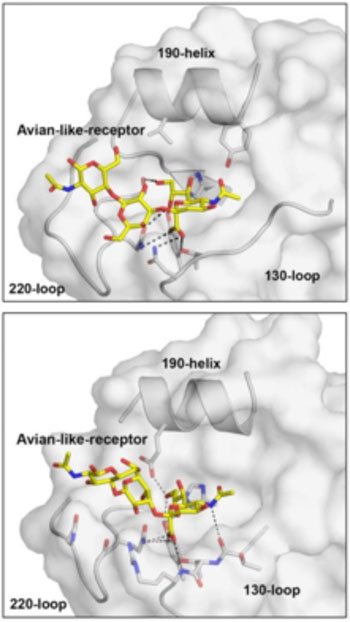Chinese Bird Flu Strains Retain Specificity for Avian Receptors
By LabMedica International staff writers
Posted on 24 Mar 2015
A team of molecular virologists found no indication of a looming "bird flu" pandemic when they determined in laboratory studies that two strains of bird flu that had sickened and killed several individuals in China were better adapted to bird cell receptors and only bound weakly to the human analogs.Posted on 24 Mar 2015
Investigators at The Scripps Research Institute (La Jolla, CA, USA) examined the two influenza subtypes H10N8 (which had infected and killed a 73-year-old woman from Jiangxi Province in late 2013) and H6N1 (which caused a nonfatal illness in a 20-year-old Taiwanese woman in June 2013). To this end they produced copies in cell culture of the viral hemagglutinin (HA) proteins based on genetic sequences obtained from Chinese scientists.

Image: A new analysis suggest that two deadly flu viruses, variants of subtypes H10N8 and H6N1, have not acquired changes that would allow them to infect people easily (Photo courtesy of the Scripps Research Institute).
Results of binding assays, sialoside glycan microarray analysis, and X-ray crystallography studies revealed that both strains preferentially interacted with avian receptor analogs rather than human ones. Furthermore, introduction of mutations into the receptor-binding site known to convert other HA subtypes from avian to human receptor specificity failed to switch preference to human receptors.
"These bird flu viruses seem able to bind to receptors on host cells in different ways and thus can probably mutate in different ways to jump to humans—so we should not be complacent about our ability to predict the viral changes required to get a pandemic," said senior author Dr. Ian A. Wilson, professor of structural biology at the Scripps Research Institute. "Determining whether a bird flu strain has truly jumped the species barrier will therefore continue to require detailed receptor-binding and structural studies like these."
Results of studies on the bird flu subtypes were published in two papers that were published in the March 11, 2015, issue of the journal Cell Host & Microbe.
Related Links:
The Scripps Research Institute













